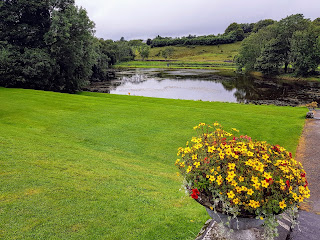The northern coast of County Mayo is less visited than other more famous parts of Ireland. Yet, both the countryside and the upper northern coast offer some outstanding sights. Some more, there are a few historical sites of utmost interest such as the Neolithic Ceide Fields, the mythic Downpatrick Head, or Turlough in the vicinity of Castlebar.
Using Castlebar as a starting point of exploration, here is a succinct description of this region of County Mayo.
 |
| North Mayo itinerary |
Using a country road to go from Castlebar to Ballycastle is not exactly the fastest way. You can't drive too fast on these tiny roads. But it remains the best way to be acquainted with the landscape.
As a matter of fact, the road winds across a hilly chain across a scenic pass that offers a panoramic view of the countryside.
 |
| Hill pass |
 |
| Hills, forest, and plain of Co. Mayo |
After Ballycastle, a junction follows the North Atlantic dramatic coastline across a vast layer of bogland. As a matter of fact, it is this bogland, which has preserved the amazing site of Ceide Fields. Another post, more historically orientated will talk about this Neolithic site, due to be a tentative UNESCO World Heritage.
As this particular report refers to the natural beauty of the environment, it remains dedicated to the high cliffs, a characteristic of the area.
 |
| The viewpoint of the north Mayo coast |
 |
| Seacliff edge |
The Céide Fields made of limestone and shale are 113m high above the Atlantic Ocean.
In Irish, 'Céide Fields' means 'a fat topped hill'. It covers a bogland having a specific form of vegetation.
Accidentally discovered in the mid 20th century, the Stone Age site is not only the oldest in Ireland but one of the only existing sites globally. The actual nature of the soil is responsible for this longstanding preservation almost 6,000 years old.
The drive along these sea cliffs is a spectacular sight. Contrary to the Cliffs of Moher that have now become a major touristic hotspot, the whole area of the Céide Coast remains wild and untouched.
Now, when you go back to the peaceful village of Ballycastle, a very narrow lane takes you to a promontory known as Downpatrick Head.
This is almost a hair-raising experience. Once you have passed the driving ambush of the way to the parking area, you need to walk for about a mile to the promontory tip and be prepared for another surprise. Apparently, the detached standing rock of Downpatrick Head is one of County Mayo's major highlights. And it sure can be! It is not only spectacular but also totally unexpected. The clifftop is covered with a smooth green kind of grass that looks unreal and feels like a soft bouncing mattress.
 |
| Clifftop moss |
 |
| Downpatrick standing rock |
It is perhaps no wonder that such a magical natural place has also become a mythical site that mixes both the pre-Celtic heritage and the early Christian world. The myth evokes a powerful magician and the emblematic figure of Saint Patrick both fighting on this very spot. And of course, the mythical fight resulted in St.Patrick's victory!
 |
| The mythical story |
More pragmatically, the promontory served also as a natural defensive viewpoint during World War II. Whatsoever, it remains a remarkable natural spot definitively worth the effort of going.
 |
| Myth & legend account |
 |
| Another geological formation |
 |
| A dramatic view of Downpatrick Head |
While visiting this place, I witnessed another unexpected and rather funny episode. I noticed an Asian couple filming. I first thought that the guy was taking a picture of his wife or girlfriend in front of the standing rock. And since I heard they were speaking what I thought was Indonesian at first, I approached them to practice on my Bahasa Indonesia. But no, they were Filipinos and my Tagalog is very basic, so I spoke with them in English! Nothing really funny until then. So after exchanging a few words, I left until I realize that the guy was filming the girl with music and that she was dancing in front of the camera, her back to the ocean! Maybe you could call that another form of modern creative myth!
 |
| Killala Round Tower |
Leaving Downpatrick Head, the road eastwards goes to the historic town of Killala.
 |
| About the history of Killala |
 |
Round Tower top
|
I have a certain fascination for the Irish Round Towers. They pertain to the concept of roundness that characterizes Irish architecture through all ages. The cosmic idea contained in the circle is prolonged in an axial verticality. Some more, the conical roof ends up into a cosmic center pointing towards the stellar vault. Their ambiguous functionality remains a bit of a mystery as many different explanations have been given. I believe they are what they stand for: a physical link between the Earth and the Cosmic order, a spiritual idea that can be applied to religious beliefs. In my own words, they fulfill the role of the Egyptian obelisks by keeping a true indigenous mark that stands for a definite sign of a strong Irish spirituality.
Anyhow, Killala is quite an interesting place. But on my way back to Castlebar, I stopped at Turlough, home of the National Museum of Ireland. This wonderful estate has a Victorian Garden.
Further up on a hill, there is also a church flanked with another example of a Round Tower.
 |
| Turlough Hill church and cemetery |
 |
| Turlough Round Tower |
 |
| Local sign commenting on the Round Tower |
This is a rich tour that includes a few outstanding natural sites as well as places of historical importance.
It takes a full day to be able to visit all these places at a reasonable pace.
C.S.























































